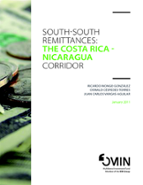South-South Remittances: The Costa Rica Nicaragua Corridor
Date
Jan 2011
Migration, while certainly not new, is on the increase all over the world. Indeed, the United Nations estimates that from 1990 to 2000 alone, the number of people who left their countries of origin rose by 14 percent, from 154 million to 175 million. The phenomenon is not only growing, but is having an impact on the economies of sending countries and receiving countries alike. The effect is visible in the labor market, income distribution, poverty, economic growth, and such areas as gender, health, education and human rights.
In particular, remittances (money that immigrants send to friends or family in their countries of origin) have been growing rapidly throughout the world since the mid-1990s. Official figures in many developing countries show that these currency flows bring in more income than both foreign direct investment (FDI) and international development aid.
Studies performed so far in Latin America show that remittance flows have a significant although moderate impact on economic and social development in receiving countries. However, these studies have failed to consider differences associated with the origin of remittances (i.e., North-South remittances versus South-South remittances). They implicitly assume that the impact of remittances is unaffected by the type of corridor through which they come. This document discuss that this assumption could prove to be mistaken if the socioeconomic profile of migrants is directly associated with the country to which they migrate and the kinds of opportunities they find for employment and compensation so as to send money home to families or friends.
In particular, remittances (money that immigrants send to friends or family in their countries of origin) have been growing rapidly throughout the world since the mid-1990s. Official figures in many developing countries show that these currency flows bring in more income than both foreign direct investment (FDI) and international development aid.
Studies performed so far in Latin America show that remittance flows have a significant although moderate impact on economic and social development in receiving countries. However, these studies have failed to consider differences associated with the origin of remittances (i.e., North-South remittances versus South-South remittances). They implicitly assume that the impact of remittances is unaffected by the type of corridor through which they come. This document discuss that this assumption could prove to be mistaken if the socioeconomic profile of migrants is directly associated with the country to which they migrate and the kinds of opportunities they find for employment and compensation so as to send money home to families or friends.




